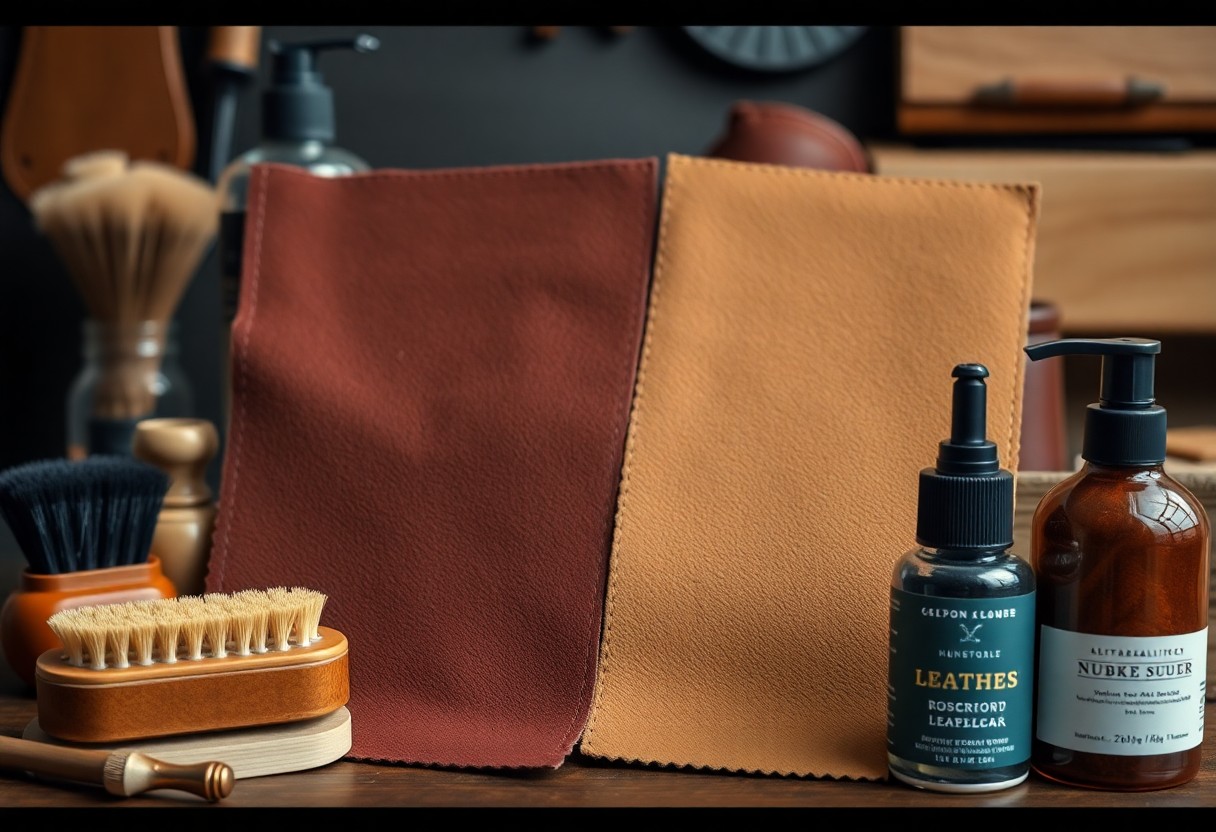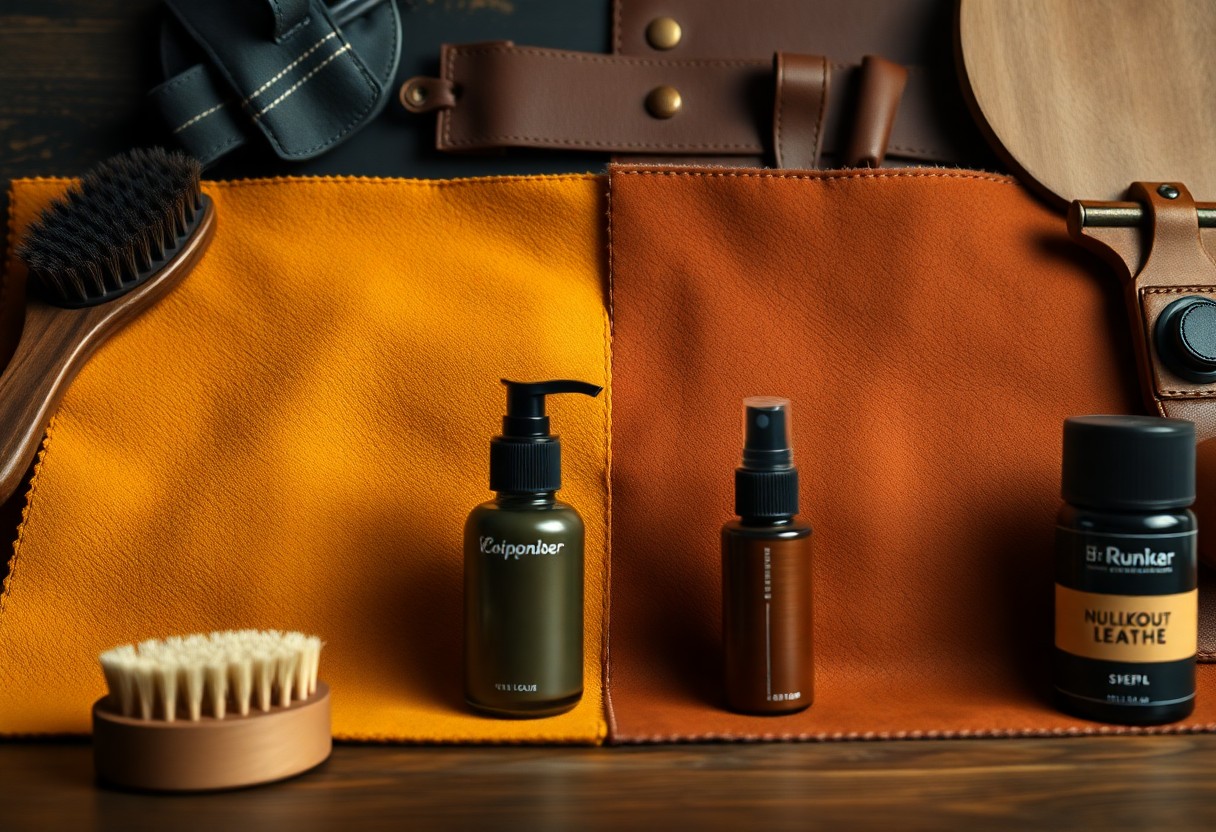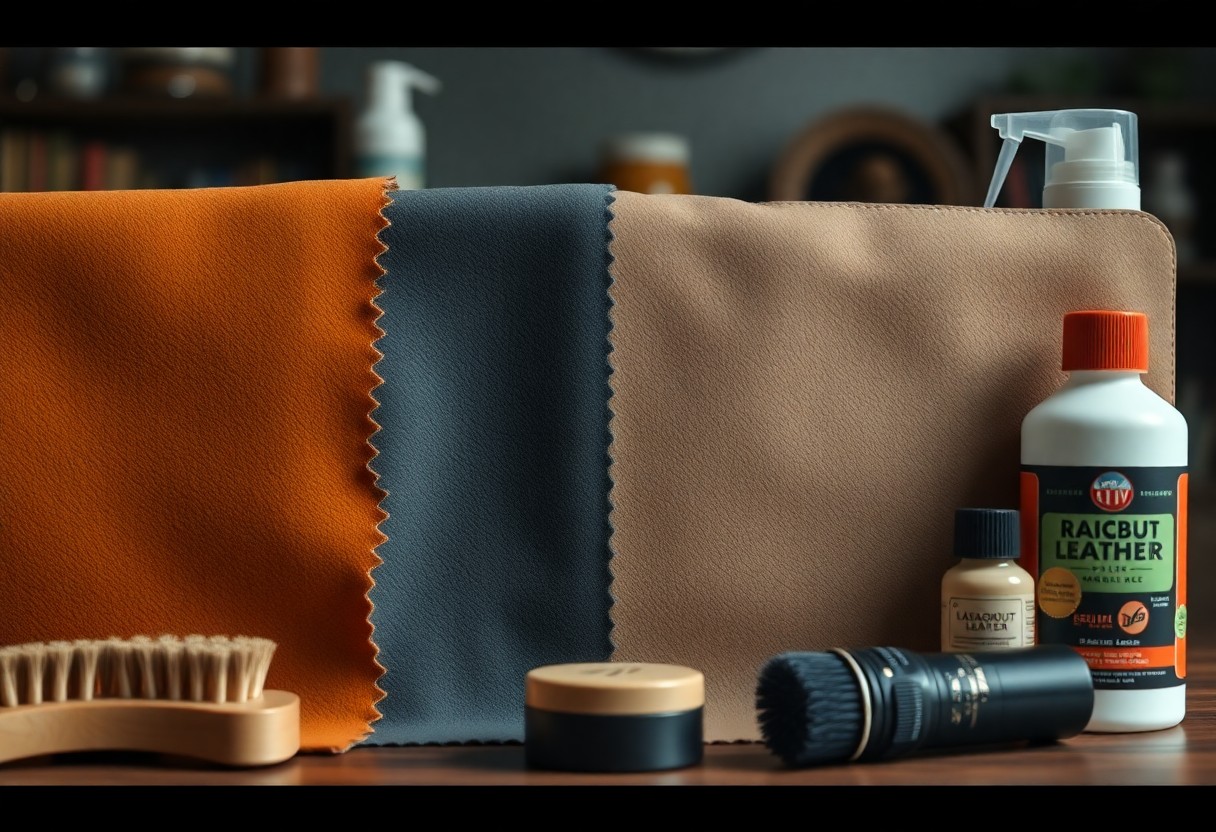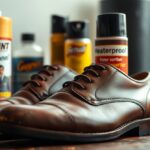Nubuck, suede, and roughout leather have unique characteristics that are essential for determining the durability and aesthetic quality of your leather products. These materials are widely used in various items, from fashionable shoes to trendy jackets, each requiring specific care methods to maintain their beauty and longevity. Nubuck is celebrated for its impressive durability, largely due to its dense grain structure, making it an excellent option for items subjected to heavy use. On the other hand, suede has a luxuriously soft texture, making it perfect for fashion-centric items. Roughout leather is particularly sensitive to water damage, necessitating additional protective measures. By understanding these differences, you can confidently choose the most appropriate leather type for your needs while ensuring proper care. This detailed guide will help you identify each leather type and provide optimal care practices for your leather goods.

Understand the Distinctive Features of Napped Leather Types for Better Choices
For both leather enthusiasts and prospective buyers, understanding the various napped leather types is vital for making informed purchasing decisions. These varieties encompass nubuck, split suede, full reverse suede, and roughout leather. Although they may look alike at first, each type boasts unique qualities and intended applications. By familiarizing yourself with these distinctions, you’ll be empowered to select the most suitable leather type that aligns with your specific needs and preferences, ultimately enhancing your overall purchasing experience.
| Type | Key Features |
|---|---|
| Nubuck | Sanded grain surface, durable |
| Split Suede | Made from corium layer, less durable |
| Full Reverse Suede | Full grain leather reversed, strong core |
| Roughout | Untreated corium surface, rugged texture |
| Care Requirements | Waterproofing needed for all types |
Uncover the Remarkable Characteristics of Nubuck Leather
While nubuck shares a similar appearance with suede, it stands out by offering superior durability due to its unique grain leather construction. The surface is meticulously sanded to create a fine, velvety nap, which enhances its resistance to wear compared to other napped leather types. This quality makes nubuck an ideal choice for individuals seeking long-lasting leather products, especially in settings where wear and tear are commonplace. Its ability to withstand daily challenges while maintaining its visual appeal is a significant advantage for consumers looking for durability in their leather goods.
Dive Into the Unique Properties of Split Suede Leather
To understand split suede, one must consider its origin, as it is crafted from the corium layer of the hide, which contributes to its unique characteristics. This type of leather features loose fibers and an appealing soft texture, making it inviting to the touch. However, it necessitates careful maintenance due to its porous quality. The different variations of split suede can vary widely depending on the animal hide used and the specific processing methods, ranging from lightweight fashion suede to heavy-duty footwear suede, each tailored for specific applications in both fashion and functionality.
Explore the Distinctive Qualities of Full Reverse Suede Leather
Understanding full reverse suede involves recognizing its unique construction, which is essentially a full-grain leather turned inside out. This innovative technique creates a suede-like surface while preserving the structural integrity of the full-grain leather. The intact grain layer enhances water resistance and durability, making it a favored choice for high-end footwear and leather goods that require both aesthetic appeal and functional reliability. Commonly found in premium products, full reverse suede offers a sophisticated look while ensuring longevity and performance, making it a sought-after option for discerning consumers.
Discover the Unique Features of Roughout Leather
The defining qualities of roughout leather include its deliberately unrefined surface and exceptional durability. With a rugged texture that distinctly sets it apart from other napped leathers, it appeals to those who appreciate a more robust and natural aesthetic. The construction of roughout leather retains the full hide structure, making it especially well-suited for work boots and outdoor equipment where resilience is a top priority. Over time, this leather type naturally ages, developing a unique patina that not only enhances its visual appeal but also tells a story of its journey.

Master the Key Differences Among Leather Types for Smart Choices
Grasping the essential differences between nubuck, suede, and roughout leather is critical when evaluating their construction and individual traits. Each type offers unique properties suited for different applications and wear conditions. By understanding these distinctions, you can make better, more informed decisions about your leather goods, ensuring you select the best options that fit your lifestyle and preferences for durability, style, and care requirements.
| Feature | Characteristics |
|---|---|
| Origin | Grain layer vs Corium layer |
| Surface | Fine vs Coarse nap |
| Durability | High to moderate resistance |
| Maintenance | Regular to intensive care |
| Applications | Footwear to accessories |
In-Depth Comparative Analysis of Material Structures in Napped Leathers
Let’s now explore how these leather types differ in their core structures:
| Leather Type | Structure |
|---|---|
| Nubuck | Sanded grain layer |
| Suede | Split corium layer |
| Roughout | Reversed full grain |
Examine Surface Texture for Enhanced Understanding
To develop a clearer understanding of the surface features, one should analyze the nap length and texture of each leather type. Nubuck features the shortest and finest nap, delivering a smooth tactile experience, while roughout showcases a more irregular, coarse texture that contributes to its ruggedness and appeal. The material differences in texture significantly affect how each leather type reacts to wear and treatment, which, in turn, influences their overall care and longevity. Notably, suede develops a distinct patina over time, adding character to its appearance, while nubuck maintains a more consistent look throughout its lifespan, showcasing its durability and resilience.
Essential Durability Factors to Consider for Long-lasting Leather
If longevity is your primary concern, it’s crucial to acknowledge the following key factors that impact the durability of leather:
- Water resistance varies significantly among the different leather types
- Wear patterns develop uniquely based on usage
- Structural integrity is determined by the specific leather type
Any surface damage requires specialized repair methods to restore it effectively. Additionally, environmental factors can significantly affect durability:
- UV exposure can alter color retention
- Temperature fluctuations impact leather flexibility
- Moisture levels influence overall material stability
When selecting protective treatments, ensure they are tailored to your specific leather type for optimal performance and longevity.
Crucial Care and Maintenance Strategies for Napped Leathers
Unlike smooth leathers, napped leathers require specific care techniques to maintain their texture and overall appearance. Your nubuck, suede, and roughout leather items need regular brushing, moisture protection, and careful cleaning to preserve their unique qualities. These materials are more vulnerable to staining and water damage compared to smooth leather, underscoring the importance of established maintenance routines to extend their lifespan and maintain their beauty.
Proven Cleaning Techniques for Napped Leather Items
To effectively clean your napped leather items, it’s best to use a specialized suede brush, working in one direction to gently remove surface dirt and debris. For stubborn stains, a suede eraser can be a helpful tool, and it’s advisable to avoid water-based cleaning methods whenever possible, as they can affect the texture. For deeper cleaning, only use products specifically formulated for your leather type, as traditional leather cleaners can adversely impact the nap and finish.
Protective Strategies for Napped Leather Durability
To protect your napped leather, applying a high-quality water repellent spray is essential. Treat new items before their initial use and reapply this protection every 3-4 months. This preventative measure creates a protective barrier while ensuring the leather maintains its breathability and natural feel. Understanding the appropriate protection methods is crucial for extending the life of your leather items. Regular maintenance includes vigilant checks for wear spots, timely reapplication of protective treatments after heavy use, and avoiding direct heat or sunlight exposure. Tailor your protection routine based on how frequently you use your items, increasing the frequency for everyday wear.
Best Storage Practices for Napped Leather
When it comes to storing napped leather, careful attention to the environment is vital. Ideally, keep your items in a cool, dry area away from direct sunlight. For footwear, using shoe trees helps maintain their shape, while stuffing bags with paper provides additional support. Never store leather items in plastic bags, as they need proper ventilation to maintain their quality and prevent mold growth.
For long-term storage, choose breathable cloth bags, ensure good air circulation, and regularly check for moisture or mold buildup. Aim for 40-50% humidity in the storage area to prevent the leather from drying out or developing mildew. Keep items separated to avoid color transfer and to preserve their individual shapes.

Investigating Practical Applications and Functions of Various Leather Types
Your choice of nubuck, suede, or roughout leather significantly influences both the durability and visual appeal of the final product. Each type serves distinct purposes based on its unique characteristics. Nubuck is perfect for high-durability applications, while suede provides a more flexible, softer option for fashion pieces, demonstrating its versatility across a range of contexts and uses.
Footwear Applications: Selecting the Right Leather Type
While all three leather types are suitable for footwear, each possesses distinct advantages. Nubuck excels in outdoor and work boots due to its unrivaled durability, while split suede is an excellent option for dress shoes and casual sneakers. Roughout leather, characterized by its rugged texture, is ideal for creating high-performance hiking boots that effectively resist scuffs and scratches, ensuring long-lasting wear in demanding environments.
Garment Manufacturing: Choosing the Best Leather for Clothing
The applications of these leathers in garment manufacturing differ greatly based on their unique properties. Suede is particularly well-suited for stylish fashion jackets, while roughout leather is favored for durable workwear that withstands the rigors of daily use and harsh conditions. Although nubuck is less common in apparel, it serves as an excellent choice for protective panels in motorcycle gear, combining style with functionality.
For example, split suede is frequently used in lightweight jackets and vests, while roughout leather is commonly chosen for heavy-duty work shirts and pants. The choice of material typically aligns with the intended use of the garment—fashion items predominantly incorporate softer suedes, while protective gear benefits from sturdier nubuck or roughout options to ensure durability and comfort.
Accessory Design: Utilizing Leather Types for Unique Creations
These leather types also play a crucial role in crafting a variety of accessories. Nubuck is perfect for designing stylish watch straps and belts, while suede is well-suited for creating attractive bags and wallets. Roughout leather is especially effective for durable outdoor gear, such as backpacks designed to endure rugged conditions and demanding adventures.
By carefully selecting materials, you can create accessories that perfectly align with their intended purposes. Split suede works best for decorative items, whereas nubuck and roughout excel in products requiring high wear resistance and longevity. Always consider potential water exposure when choosing the appropriate leather type for outdoor accessories to ensure they remain functional and visually appealing over time.
Recognizing Factors That Impact Leather Quality
It is essential to acknowledge that the quality of napped leather is influenced by several critical factors, including hide selection, tanning processes, and manufacturing techniques. These key considerations play a significant role in determining the durability and aesthetic appeal of the final product.
Significance of Hide Selection for Superior Leather Quality
To ensure the highest quality, it is crucial to recognize that premium hides originate from animals that are raised under optimal conditions. These superior hides exhibit fewer surface imperfections and feature a more consistent fiber structure. The quality of your leather begins with selecting hides that have minimal scarring and possess the appropriate thickness, which greatly influences the final product’s performance and appearance.
Impact of Tanning Processes on Leather Characteristics
The tanning process, whether it is vegetable or chrome tanning, significantly impacts the ultimate quality of the leather. Each method imparts different characteristics related to water resistance, flexibility, and color absorption. This crucial stage requires meticulous control over temperature, pH levels, and chemical concentrations, as these factors directly affect the durability and texture of your leather during the extensive 4-6 week tanning period.
Manufacturing Processes That Shape Leather Quality
In the production of napped leather, specialized buffing techniques are utilized to create the distinctive surface texture that characterizes these materials. The final appearance of your leather is heavily influenced by the depth of buffing and the exposure of fibers during this process. A consistent manufacturing approach is vital for ensuring uniform nap height and direction, as these elements are closely linked to the leather’s wear resistance and overall aesthetic appeal, ultimately impacting consumer satisfaction.
Evaluating the Pros and Cons of Napped Leather Types
Each type of napped leather offers unique features that make it suitable for various applications. Your decision between nubuck, suede, and roughout leather should be guided by your specific needs and intended applications, ensuring that you select the best option for your situation.
| Pros | Cons |
|---|---|
| Unique aesthetic appeal | Requires regular maintenance |
| Soft, comfortable texture | More susceptible to water damage |
| Good breathability | Shows wear marks easily |
| Various color options | Needs special cleaning products |
| Versatile applications | Higher maintenance costs |
Understanding the Benefits of Each Napped Leather Type
Every type of napped leather presents specific advantages tailored to different needs. Nubuck offers superior durability thanks to its dense grain structure, making it ideal for high-use items. In contrast, suede provides excellent flexibility and softness, making it perfect for fashion-forward designs. Meanwhile, roughout leather combines unique texture with strength, making it a versatile choice for a variety of applications, especially in outdoor equipment and workwear.
Limitations and Considerations for Napped Leather Usage
Despite their distinct characteristics, each leather type has its limitations. Water exposure can severely compromise untreated napped leathers, and consistent maintenance is crucial to preserving their appearance and integrity over time. Your selection should reflect your intended use: indoor applications typically carry fewer risks than outdoor scenarios, and factors such as climate and frequency of wear will directly affect the leather’s durability and performance.
Ultimately, your understanding of nubuck, suede, and roughout leather will empower you to make informed choices for your leather goods. You can now recognize the critical differences among these leather types based on their construction, durability, and care requirements. By implementing the appropriate care methods for each type—such as utilizing waterproof sprays for nubuck, gentle brushing for suede, and specialized treatments for roughout leather—you can significantly prolong the life of your leather items. This knowledge equips you to select the best leather type for your specific needs while maintaining its quality over time.
Addressing Common Questions About Napped Leather
What are the main differences between nubuck and suede leather?
Nubuck uses the grain layer of leather, which is lightly sanded on the surface, resulting in greater durability and water resistance. In contrast, suede is derived from the softer bottom layer (corium) of the hide, making it more porous and less resilient. Additionally, nubuck features a shorter and finer nap compared to the longer, softer texture of suede, enhancing its appeal for long-term use.
What are the best practices for cleaning and protecting napped leathers?
For optimal care, always apply a waterproof spray to all napped leathers before initial use. Clean them using a specialized suede brush to effectively remove dirt and restore the nap. For stains, utilize dedicated suede or nubuck cleaners. Avoid exposing these leathers to heavy rain, and allow wet items to dry naturally at room temperature. After drying, brush the leather to restore its original nap and texture.
What differentiates roughout leather from reverse suede?
Roughout leather retains the untreated and rough corium layer, while reverse suede has this layer sanded smooth. Both leather types feature the grain layer facing inward, enhancing their durability compared to split suede. However, roughout presents a more textured and uneven surface compared to reverse suede’s uniform nap. Both are ideal for unlined shoes due to the smoothness of their flesh sides, providing comfort and durability.
The Article Guide to nubuck suede and roughout leather differences, care tips, and uses appeared first on My Shoes Finder
2 thoughts on “Care Tips and Uses for Nubuck Suede and Roughout Leather”
Comments are closed.



Your exploration of nubuck, suede, and roughout leather really highlights the importance of understanding material characteristics in relation to both aesthetics and durability. I find it fascinating how different lifestyles can dictate the best choice in leather—someone who frequently travels or spends time outdoors might lean towards nubuck for its resilience, while another who enjoys fashion-forward pieces might opt for the luxurious touch of suede.
I agree; the way different materials align with various lifestyles is intriguing. It’s interesting how our daily activities can shape our preferences, especially when it comes to something as tactile as leather. Nubuck’s resilience definitely makes it appealing for those of us who are often outdoors or on the go—it has that perfect balance of durability and a soft touch, which is a rare find.